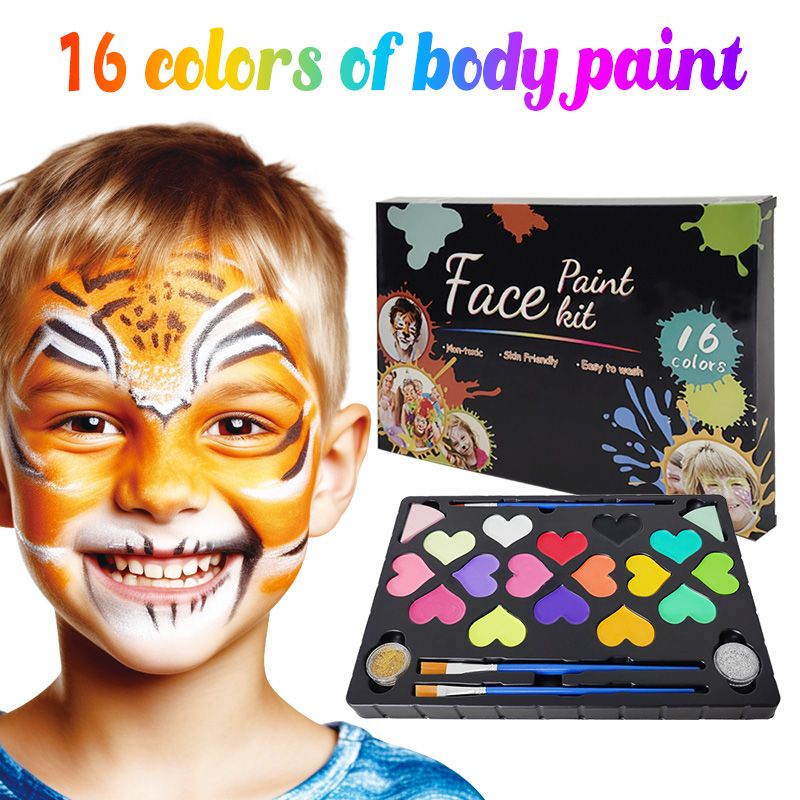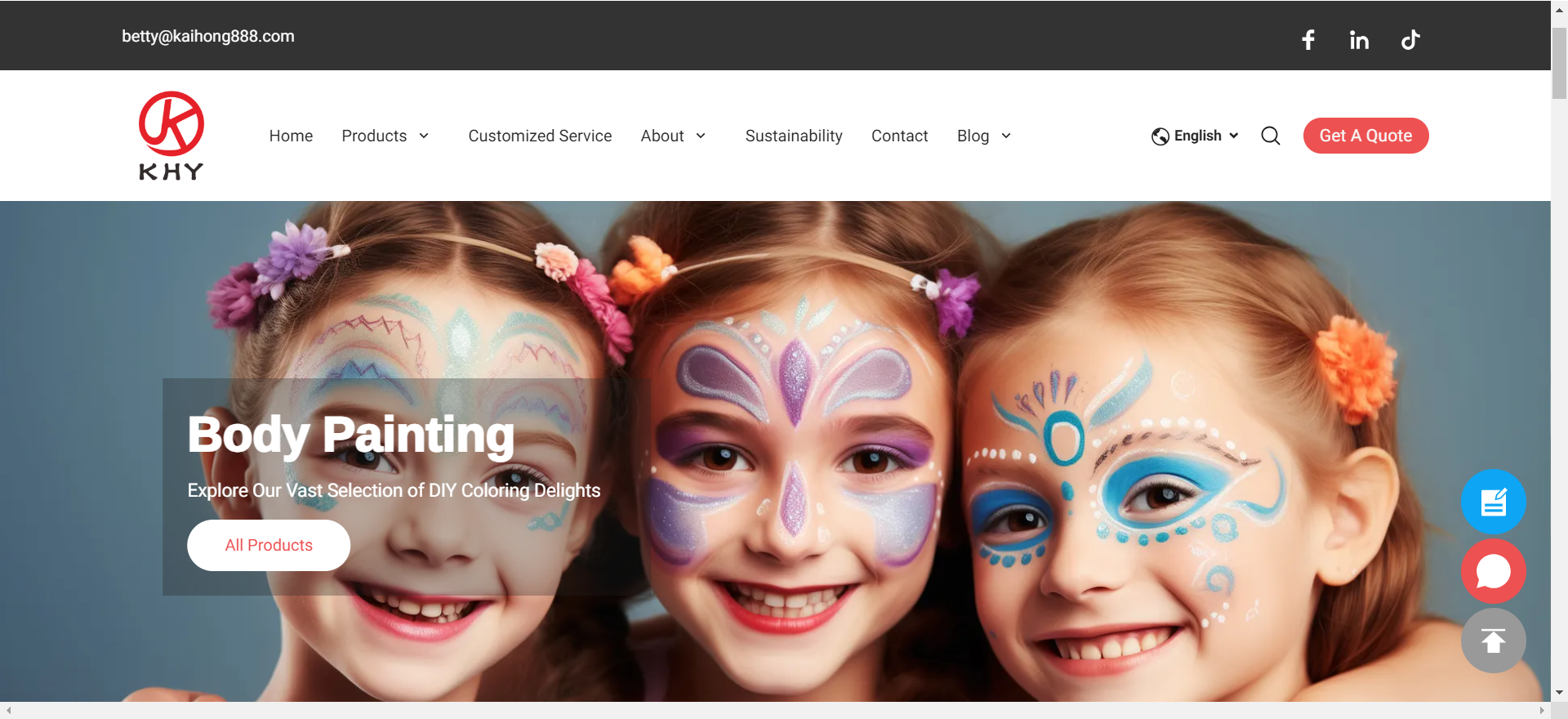betty@kaihong888.com

Get A Quote
What Is Professional Face Paint Made Of?
Face paints have been a staple in various cultures for centuries, serving purposes ranging from artistic expression and cultural rituals to professional makeup for performers and athletes. Today, professional face paint is a highly specialized product, designed to meet the rigorous demands of both professional makeup artists and enthusiastic amateurs. This article delves into the composition of professional face paints, uncovering what makes them both safe and effective.
The Basics of Face Paints
Face paints are designed specifically for application on the skin, requiring them to meet stringent safety standards. Unlike other types of paint, face paints need to be non-toxic, hypoallergenic, and easy to remove. They also need to provide vibrant colors, smooth application, and long-lasting wear.
Key Ingredients in Professional Face Paints
- Water: Water is the primary solvent in many professional face paints, especially water-activated varieties. It allows for easy application and removal. Water-based face paints are popular because they dry quickly, are less likely to clog pores, and are generally considered more comfortable for extended wear.
- Glycerin: Glycerin is a humectant that helps to keep the paint from drying out too quickly on the skin. It adds a moisturizing element, making the paint feel more comfortable and flexible once applied.
- Paraffin Wax: Some face paints, especially those used for theatrical performances, contain paraffin wax. This ingredient helps the paint adhere better to the skin and provides a longer-lasting finish. It also allows for more intricate detailing and layering.
- Pigments: Pigments are the core of any face paint, providing the vibrant colors that are essential for professional-grade products. These pigments can be natural or synthetic and are chosen for their intensity and safety. Common pigments include iron oxides, titanium dioxide, and various FD&C (Food, Drug, and Cosmetic) approved colors.
- Binders: Binders help the pigments adhere to the skin and maintain their color intensity. Common binders in professional face paints include natural resins and polymers, which ensure the paint remains in place even under challenging conditions like sweat and movement.
- Preservatives: To ensure the longevity and safety of face paints, preservatives are added to prevent the growth of bacteria and mold. Common preservatives include parabens and phenoxyethanol, though many brands are now opting for more natural alternatives to appeal to health-conscious consumers.
Specialty Additives
Professional face paints often include specialty additives to enhance performance and appearance:
- Metallic Flakes: For a shimmering effect, metallic flakes or mica particles are added. These are popular in designs that require a bit of sparkle, like fantasy characters or festive looks.
- Glitters: Cosmetic-grade glitters can add a dazzling effect to face paints. These glitters are specifically designed to be safe for use on the skin, unlike craft glitters which can cause irritation.
- UV Reactive Pigments: For a dramatic effect under blacklight, UV reactive pigments are used. These are popular in nightclub scenes and special events like Halloween.
- Silicones: Some high-end face paints use silicones to improve spreadability and durability. Silicones can make the paint water-resistant and provide a silky-smooth finish.
Ensuring Safety and Quality
When choosing professional face paints, safety is paramount. Here are some tips to ensure you're using a high-quality product:
- Check for FDA Approval: In the United States, face paints should be FDA-approved or compliant with cosmetic regulations. This ensures that the ingredients have been tested for safety.
- Patch Test: Always conduct a patch test before full application, especially if you have sensitive skin. Apply a small amount of paint to the inside of your wrist and wait 24 hours to check for any adverse reactions.
- Read Reviews: Look for reviews from other users, particularly those with similar skin types or who have used the paint for similar purposes. This can provide insight into the product's performance and any potential issues.
- Opt for Known Brands: Established brands are more likely to adhere to safety standards and produce consistent, high-quality products. With nearly 20 years of industry experience, KHY is a trusted leader in DIY paint wholesale. If you need to buy fabric paint in bulk, KHY DIY paint must be your best choice.
The Evolution of Face Paints
Historical Use
Face paints have a rich history. Ancient cultures used natural pigments from plants and minerals for ceremonial purposes, tribal markings, and war paint. The Egyptians, for example, famously used kohl and malachite for both aesthetic and protective reasons.
Modern Innovations
Today, face paints have evolved significantly. Modern technology allows for the creation of highly pigmented, long-lasting, and skin-safe products. Innovations in cosmetic chemistry have introduced new materials that improve performance and user experience. For instance, hypoallergenic formulas are now more common, catering to people with sensitive skin.
Eco-Friendly Options
With growing environmental awareness, many manufacturers are developing eco-friendly face paints. These products often use biodegradable glitter, natural pigments, and sustainable packaging. Eco-friendly face paints are gaining popularity as consumers become more conscious of their environmental impact.
Application Tips for Professional Results
To achieve the best results with professional face paints, consider the following tips:
- Start with Clean Skin: Ensure the skin is clean and dry before applying face paint. This helps the paint adhere better and last longer.
- Use Quality Brushes and Sponges: Investing in good quality application tools can make a significant difference in the smoothness and precision of your face paint designs.
- Layer for Intensity: For more vibrant colors, apply the paint in thin layers, allowing each layer to dry before applying the next. This prevents cracking and ensures an even finish.
- Set with Powder: For longer-lasting results, especially in hot or humid conditions, set your face paint with a translucent setting powder. This helps to absorb excess moisture and reduce smudging.
- Use Fixative Sprays: Professional makeup fixative sprays can help lock in your face paint design, making it more resistant to sweat and friction.
- Remove Gently: At the end of the day, use a gentle makeup remover or baby wipes to remove the face paint. Avoid harsh scrubbing, which can irritate the skin.
Creative Uses of Professional Face Paints
Professional face paints are incredibly versatile and can be used for a wide range of creative applications:
- Theatrical Performances: From stage plays to opera, face paints are essential for creating dramatic, expressive looks that are visible from a distance.
- Festivals and Carnivals: Events like Mardi Gras, Halloween, and Day of the Dead see extensive use of face paints for intricate, vibrant designs.
- Sports Events: Fans often use face paints to show their support for their favorite teams, incorporating team colors and logos into their designs.
- Cosplay: Cosplayers use professional face paints to transform into their favorite characters, requiring durable and highly pigmented products to achieve the desired look.
- Children's Parties: Face painting is a popular activity at children’s parties, where safe, non-toxic paints are used to create fun designs like animals, superheroes, and fantasy creatures.
Conclusion
Professional face paints are a blend of carefully selected ingredients designed to provide vibrant, long-lasting color while being safe for the skin. Understanding what goes into these paints can help you make informed choices and achieve stunning results. Whether you’re preparing for a theatrical performance, a festive event, or a creative photoshoot, knowing the components of your face paint ensures you can apply it with confidence and flair.
To truly unlock your creative potential, consider KHY and their comprehensive range of DIY body painting supplies. KHY offers a wide array of face paints that are safe for the skin, vibrantly colored, and suitable for both amateurs and professionals. Their products are designed with the utmost care to ensure they meet the highest standards of quality and safety. Choose KHY for a reliable and exciting face painting experience that will elevate your creativity to new heights.

